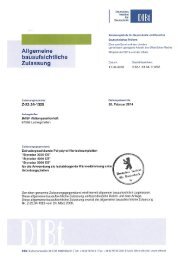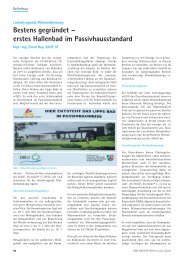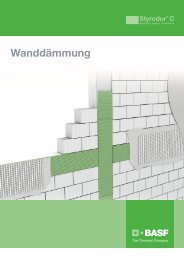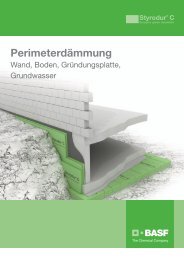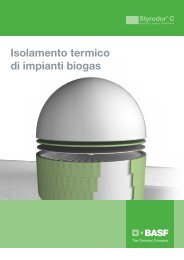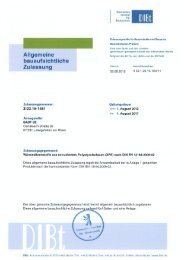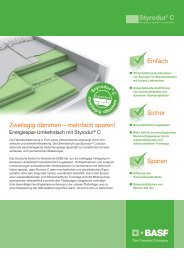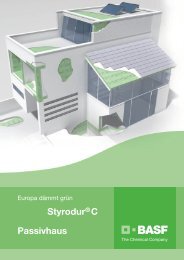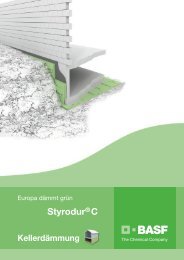Hünig's base from BASF for more efficient pharmaceutical synthesis
Hünig's base from BASF for more efficient pharmaceutical synthesis
Hünig's base from BASF for more efficient pharmaceutical synthesis
You also want an ePaper? Increase the reach of your titles
YUMPU automatically turns print PDFs into web optimized ePapers that Google loves.
Hünig’s <strong>base</strong> <strong>from</strong> <strong>BASF</strong><br />
<strong>for</strong> <strong>more</strong> <strong>efficient</strong> <strong>pharmaceutical</strong> <strong>synthesis</strong><br />
By Dr. Thorsten Volk, <strong>BASF</strong><br />
Hünig’s <strong>base</strong> (N,N-diisopropylethylamine, DIPEA) – a colorless, slightly<br />
oily, flammable liquid – is a proton scavenger used mainly in the<br />
<strong>pharmaceutical</strong> industry <strong>for</strong> the <strong>synthesis</strong> of active <strong>pharmaceutical</strong><br />
ingredients (APIs). It is also employed in the manufacture of agricultural<br />
chemicals. Typical applications <strong>for</strong> Hünig’s <strong>base</strong> include chemical<br />
reactions such as acylation, elimination and alkylation of secondary<br />
amines with alkyl halogenides, where the respective halogen acid is<br />
generated in the course of the reaction. The halogen acid reacts with<br />
the nitrogen function of Hünig’s <strong>base</strong> and ammonium salts <strong>for</strong>m<br />
accordingly. Without Hünig’s <strong>base</strong>, some of the synthesized tertiary<br />
amine would take on the role of proton scavenger and hence reduce the<br />
yield. Although it must be strong, the auxiliary <strong>base</strong> must not be<br />
nucleophilic enough to act as an alkylating agent in its own right.<br />
Hünig’s <strong>base</strong> meets all the requirements <strong>for</strong> an auxiliary <strong>base</strong>. Its<br />
nucleophilicity is low due to steric hindrance, enabling its use in<br />
chemical reactions as a strong <strong>base</strong> and “proton sponge”. Unwanted<br />
secondary reactions do not occur because, unlike similar reagents such<br />
as di- and triethylamine which have both nucleophilic and basic<br />
properties, Hünig’s <strong>base</strong> is not capable of replacing the intended<br />
reaction partner due to its built-in steric hindrance.<br />
Prominent examples where Hünig’s <strong>base</strong> is used to great effect in the<br />
<strong>synthesis</strong> of complex precursors of active <strong>pharmaceutical</strong> ingredients<br />
include the drugs Valsartan and Pravastatin.<br />
Valsartan (Novartis) belongs a the class of drugs called non-peptide<br />
angiotensin II receptor antagonists. It is primarily used to treat high<br />
blood pressure. The drug is composed of a biphenyl structure<br />
substituted with a tetrazole group and another substituent containing an<br />
L-valine unit. The L-valine unit is converted to carbonic acid amide by<br />
aminolysis at room temperature whilst adding DIPEA. The hydrochloric<br />
acid generated during this reaction is bound by the Hünig’s <strong>base</strong> acting<br />
as a proton sponge [1].
Pravastatin (Pfizer) is a semisynthetic HMG-CoA reductase inhibitor<br />
(statin) with lipid-lowering properties. The enzyme which determines the<br />
pace of cholesterol <strong>synthesis</strong>, HMG-CoA reductase, is subject to<br />
competitive inhibition. Treatment with an HMG-CoA reductase inhibitor<br />
produces a dose-dependent reduction of plasma levels of total<br />
cholesterol and LDL cholesterol of up to 50 percent. Hünig’s <strong>base</strong> is<br />
successfully used as a proton scavenger in the <strong>synthesis</strong> of a precursor<br />
of the active <strong>pharmaceutical</strong> ingredient <strong>for</strong> nucleophilic substitution at<br />
the saturated carbon atom. Esterification with an alkyl halogenide takes<br />
place – <strong>base</strong>d on carbonic acid as an intermediate – and the hydrogen<br />
halogenide thus produced is bound by DIPEA [2].<br />
Another advantage of Hünig’s <strong>base</strong> <strong>for</strong> its application in chemical<br />
<strong>synthesis</strong> is that it is readily soluble in many organic solvents. At the<br />
same time, its hydrophilicity as a free <strong>base</strong> is so low that it is easy to<br />
recover in the process. One possible option is to extract Hünig’s <strong>base</strong><br />
into the aqueous phase as an ammonium salt <strong>from</strong> organic reaction<br />
mixtures that are not miscible with water.<br />
<strong>BASF</strong>, the world’s leading chemical company with its headquarters at<br />
Ludwigshafen, Germany has been a supplier of Hünig’s <strong>base</strong> and other<br />
proton scavengers since the mid-1990s. Other N-<strong>base</strong>s with protein<br />
scavenger properties similar to those of Hünig’s <strong>base</strong> include<br />
tritethylamine, tributylamine, 1,8-diazabicyclo-[5.4.0]undecen-7 (DBU),<br />
methylmorpholine and ethylmorpholine.<br />
However, the <strong>synthesis</strong> <strong>for</strong> the manufacture of DIPEA which was<br />
per<strong>for</strong>med in a continuous process at the Ludwigshafen site was<br />
unsatisfactory in terms of the product purity obtained. Moreover,<br />
manufacturing costs were high and yields low. Starting materials had to<br />
be discarded, resulting in high disposal costs.<br />
In response to these difficulties and in recognition of the market<br />
potential <strong>for</strong> high purity Hünig’s <strong>base</strong> in the <strong>pharmaceutical</strong> and<br />
agricultural chemicals industries, <strong>BASF</strong> Research and Development<br />
brought an improved technology to market readiness in record time<br />
which produced higher-purity Hünig’s <strong>base</strong> coupled with much higher<br />
yields. Although the starting date <strong>for</strong> modification of the manufacturing<br />
technology was not until the end of May 2005, production on a<br />
commercial scale was initialized as early as January 2006. Comparison<br />
of the <strong>for</strong>mer continuous process with the new batch process <strong>for</strong><br />
manufacture of Hünig’s <strong>base</strong> shows that – in addition to the higher<br />
purity – yields are higher and waste is lower. A guaranteed product<br />
purity of 99.5% or higher meets customer requirements, in particular<br />
those of the <strong>pharmaceutical</strong> industry. It enhances the process as a<br />
whole when the high purity of an auxiliary reagent such as Hünig’s <strong>base</strong><br />
results in fewer by-products during <strong>synthesis</strong> of an active<br />
<strong>pharmaceutical</strong> ingredient. It enhances the efficiency of the reaction<br />
process and lowers manufacturing costs, ultimately boosting overall<br />
cost-effectiveness.
The newly developed technology <strong>for</strong> the manufacture of Hünig’s <strong>base</strong><br />
constitutes a significant improvement in terms of sustainable<br />
development and environmental compatibility. Unlike the diethylsulfate<strong>base</strong>d<br />
processes used by a number of other suppliers, the <strong>BASF</strong><br />
process uses environmentally compatible starting materials like<br />
diisopropylamine and acetaldehyde. The high reaction yield produces<br />
less waste, and any waste produced is eliminated without any problems<br />
in a state of the art residue incineration plant.<br />
The <strong>BASF</strong> Intermediates Division is responsible <strong>for</strong> global development,<br />
production and marketing of Hünig’s <strong>base</strong> in addition to another 600<br />
products such as diols, amines, polyalcohols and acids. One of <strong>BASF</strong>’s<br />
major strengths is the high production capacities (<strong>more</strong> than 100 metric<br />
tons annually) in place at the Ludwigshafen site, the availability of single<br />
container solutions, and customized packaging and logistics solutions.<br />
Supplier reliability is excellent. <strong>BASF</strong> is also a reliable partner <strong>for</strong> users<br />
striving <strong>for</strong> <strong>more</strong> successful production processes on the basis of<br />
intelligent solutions and top quality products.<br />
[1] Eur. Pat. Appl. EP 443, 983 (1991), Priority CH Appl. 90/518,<br />
19 Feb 1990 (Ciba-Geigy)<br />
[2] Drugs Fut 1997, 22 (11), 1205<br />
Dr. Thorsten Volk<br />
Marketing Specialty Amines<br />
<strong>BASF</strong> Intermediates Division<br />
Phone +49 621 60-49662<br />
Fax +49 621 60-21033<br />
E-Mail: thorsten.volk@basf.com



